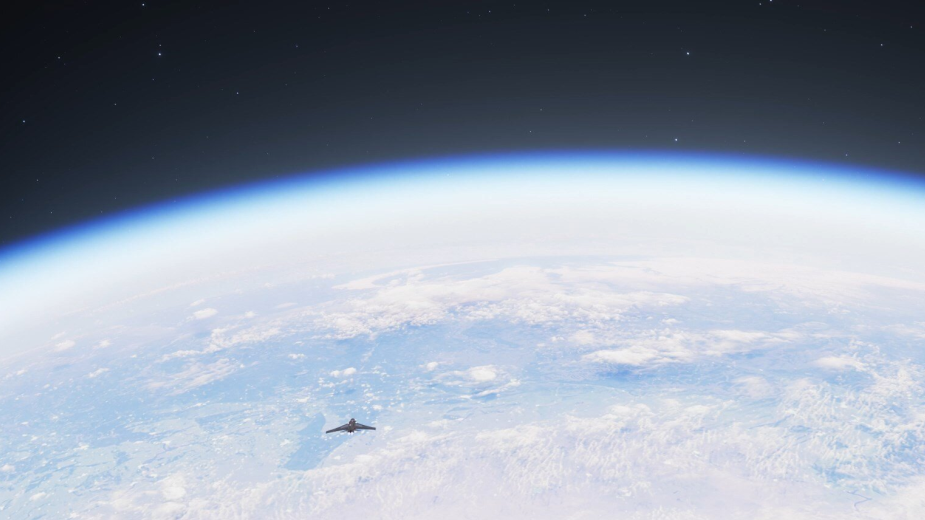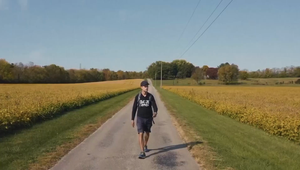
Creating the Sounds of Space Flight with Alan Lemoine's 'The Ascent'

The Ascent is a short CGI film created by Alan Lemoine during the Covid-19 pandemic lockdown between April and May 2021.
Space exploration has always been one of Alan’s strongest interests. In April of 2021, while temporarily living with his parents in France during the Covid-19 lockdown, his days consisted of remote working all day and then coming down in the evening to watch TV. As wonderful as spending time with his parents was, days and weeks were quickly becoming a messy blur as time went on.
Until one day, he saw something on TV that changed the course of his year. He was watching season 3 of The Crown on Netflix. Specifically, an episode that takes place during the moon landing of 1969.
In that episode, the King takes control of his private jet and decides to ascend to over 48,000 feet, an altitude far higher than what his aircraft is designed for, to try and feel something comparable to what the astronauts felt on their rocket to the moon.
The cinematography of the shot, the sound design, and the visual effects transported Alan right next to him in his plane, and he felt the jet shake under his feet, while looking at the moon in the distance behind the clouds.
At that moment, he knew he wanted to create something that would make people feel what he felt when he watched that scene.
It was decided: lockdown wasn’t going to be for nothing. Alan was going to make a new fully 3D CGI film, and it would be called THE ASCENT.
STEP 1: Creating the assets.
Alan started by modelling the spaceship in Cinema 4D, using references first, and then he let it evolve naturally with his imagination, taking inspiration from actual fighter jets such as the F16 and sport cars such as Lamborghinis.
When happy with the final look of the ship, it was time for texturing with Substance Painter. This was the first time Alan was properly using this software. He had to think about what the spaceship would look like. He added rust, decals, LED screens, metal bars, wear and tear, and gave it a menacing and futuristic look while also keeping it grounded in our time.
He then created an entire animated sequence for the cockpit screens with Adobe After Effects. The cockpit scenes would be slightly out of focus, so all that was really needed was to have enough flashing lights and movements to make the scene feel more real instead of a CGI asset. He added an altitude sensor display, main engine cut-off status, dynamic fuel gauge and other LEDs to make the interior of the ship come alive.
All these textures were also extremely important because they would be reflected in the canopy glass and onto the astronaut’s helmet.
STEP 2 : Creating the environment.
Creating all the environments around the spaceship was the most challenging aspect of this film. The film would start in the hangar for the take off scene. It had to be perfect. Every screw, bolt, sticker, floor tile texture, and light were precisely thought of and went through hundreds of iterations.
Alan used references of actual fighter jet hangars to help through this process, but he also used his imagination to create this unique setting for the spaceship. He used many 3D assets to populate the area with spare parts, computers and elevators which gave the scene a greater degree of realism.
While making the environments and seeing the film grow in his head, Alan also knew a scene was needed where the camera could fly through the mountains as the ship was ascending. This proved to be an extremely difficult and time consuming task using traditional rendering techniques with Cinema 4D and Octane Render due to the size of height-maps used to create a chain of mountains, high resolution textures for snow, and water effects.
Here, Alan used Unreal Engine 4 and Brushify. These real-time tools were essential to building a fully 3D mountain environment where the ship could fly through and have the camera look everywhere I wanted without any restrictions.
Next, he needed to build the engine exhaust effect. Alan had a lot of fun making this effect with Embergen, a fully procedural and real-time 3D fire and smoke simulation software. What he needed to do first however was figure out and design what the flames were going to look like and then imported the simulation into his 3D scene using a VDB sequence in Octane.
STEP 3: Cinematic storytelling.
3D modeling and texturing was not the only challenge in making this film. The storytelling aspect was equally as important.
What path would the astronaut take to walk to the spaceship?
How was he going to appear on screen?
How can I make the viewer care about him?
Where is he going?
Being so deep into the technical 3D aspect of this film, it was easy to forget what story was being told. Alan created a storyboard to figure out what scenes were needed, where to place the camera, what lens to use, what to focus on etc. Alan spent about a week on the storyboarding, until he settled on the final narrative scenes you see in the final film;
The elevator would bring the astronaut down into the camera view, and the camera would then pan to the right as a big reveal, showing the hangar and pulling the spaceship into focus.
During the cockpit scenes, the moon in the distance would be used to draw the eye of the viewer and emphasize the idea that the scene takes place high in the sky, especially when dark space and stars take over the blue atmosphere.
There was just one final storytelling challenge: how to show the spaceship actually moving when you have no point of reference ?
That is where the clouds came in. These are fully 3D volumetric clouds that Alan needed to throw into the camera as fast as he could to give the illusion that the ship was actually moving from one point to another.
STEP 4 : Sound Design
50 days later, the film was done. What it needed next was sound design and music to bring this mute film to life.
Music for the Ascent
19 Sound's Jack, Will and Oscar were absolutely wowed by the quality of Alan's work. The attention to detail, the photographic realism, was beautiful.
The idea was ostensibly simple: a man takes off from a hangar in an airplane and travels through the atmosphere to see the world from above. A kind of near future science fiction that is bold, dynamic, and incredibly well animated. The team aimed to draw out the details of this in the score and sound design, and also to add a big, dynamic, punchy impact to the narrative.
The references were big modern action films and game soundtracks, with scores that combined electronic, classical and ambient elements.
Composer Jack Wyllie started by creating an ambient bed to sit very lightly underneath the sound design; then slow moving synths, combined with high violins subtly began to emerge, leaving plenty of room in the mix for the atmosphere and general cacophony of a working aircraft hangar, that was primed for an imminent launch. For the music to have real impact it was decided to hold back, until we see the aircraft in flight for the first time.
Jack then started building fast paced rhythm tracks with dense arpeggiated synths to highlight the launch and speed of the flight. Using drum machines as well as acoustic snares and big timpani drums to build momentum with take off. They continue building this up almost to the point where it couldn't get any more intense, mirroring the scene where the pilot breaks through the atmosphere, followed by a moment of calm when he’s through and sees the world from above. We can hear the pulse of a synth, reflecting the high intensity of the pilot's journey, but we also hear a more blissful musical moment; a state of wonder and enlightenment.
The Ascent - sound design
Jack & Will worked on the sound design and music in tandem, so that both elements could grow, organically together. It's a way that they like to work whenever possible, as it means they can fine tune musical elements to match certain pitches in the sound design and vice versa. That is one of the most satisfying things about doing what they do. That moment where you’ve inadvertently created a harmony between the subby rumble of a cockpit and the synth swell that is playing underneath it. Pure joy!
The hangar was a key starting point in terms of sound design. Getting the feel of a busy, fully functioning room was really important and something that Alan wanted to get right. Will Ward built layer upon layer of room tone, adding in subtle spots in the stereo. Things that may not even be noticed, but overall, they add to the general sense of being in this space and the anticipation of what is about to happen.
Creating the sound of the spaceship taking off required something special. Will played around with SFX and layers of engine sounds, which sounded great, but not particularly unique. So he reached for Omnisphere’s powerful synth engine to help things along. After experimenting with a whole host of synth sweeps and swells, he eventually found a balance that was perfect. The end result is a sound that is unusual and thrilling. A heavy shrill of a sound that pushes out, as the aircraft leaves the hangar; leaving behind a residue of sonic debris, reminding the viewer that something big has just happened.
The next stage was the the flight sequence itself, which was a fun exercise in editing apart from anything else. Similar to working on a car chase scene, or any fast action sequence, Will needed to cut between the intense force of wind and aircraft noise on the outside, to the internal, claustrophobic, rattling space inside the cockpit. This made for a really exciting and dynamic sonic experience. These cuts had to be tight and exact in order for this effect to work. Throughout this whole sequence we cut back and forth with the occasional flyby, which required densely layered sounds, reaffirming again the power of the aircraft and the speeds it can reach.
The climax, as described earlier, is met with the closeness of being in the cockpit with the pilot. His breathing becomes clear and is prominent in the mix. The aircraft rattling and sense of speed has gone and we are left to gaze with wonder and what he has achieved. The pilot's intentions are made clear in this moment. His view of the world from above is awe inspiring.















